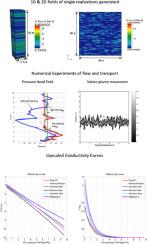当前位置:
X-MOL 学术
›
Adv. Water Resour.
›
论文详情
Our official English website, www.x-mol.net, welcomes your feedback! (Note: you will need to create a separate account there.)
Effective Flow and Transport Properties of Heterogeneous Unsaturated Soils
Advances in Water Resources ( IF 4.7 ) Pub Date : 2020-09-01 , DOI: 10.1016/j.advwatres.2020.103655 Veena S. Soraganvi , Rachid Ababou , M.S. Mohan Kumar
Advances in Water Resources ( IF 4.7 ) Pub Date : 2020-09-01 , DOI: 10.1016/j.advwatres.2020.103655 Veena S. Soraganvi , Rachid Ababou , M.S. Mohan Kumar

|
Abstract The heterogeneity of field scale soils poses a challenge to predictive large scale flow and transport modeling. The theory of effective macroscale parameters holds good and is applicable in dealing with such problems. But the validity of the analytic stochastic solutions obtained for randomly heterogeneous soils is debatable, as the test cases under which they are validated are of limited scope due to linearization and perturbation approximations. In this study, samples of heterogeneous soils are generated using sets of spatially correlated random field parameters that are either geometrically isotropic, or else, geometrically anisotropic with either horizontal or vertical stratification (perfect or imperfect). Several combinations of ratios of correlation length and capillary dispersion lengths are considered. Numerical simulations of unsaturated flow are performed on each randomly heterogeneous soil sample. The principal components K ^ ii ( Ψ ) of the macroscale effective unsaturated conductivity are then obtained as a function of the mean suction Ψ of the sample. They are compared to stochastic spectral perturbation theory, and to a probabilistic semi-empirical Power Average Model (PAM). They are also compared with arithmetic, geometric and harmonic mean conductivity-suction curves. The numerically upscaled principal conductivity curves match quite well the PAM, better than the classical means (Arithmetic, Geometric, Harmonic), and also somewhat better than the curves obtained from stochastic spectral perturbation theory. It is observed that the upscaled principal components Kii(ψ), obtained numerically and with the PAM along directions “i” orthogonal/parallel to perfect stratification coincide with the harmonic/arithmetic mean curves at low suctions (i.e., near saturation), but deviate from it and come closer to the geometric mean at higher suctions. The PAM appears suitable for generation of approximate upscaled conductivity curves, e.g., for obtaining the mesh-scale or block-scale conductivity curves in large scale simulation codes. Transient solute transport simulations are then performed on the detailed random velocity fields obtained from the steady state simulations of unsaturated flow in the randomly heterogeneous soil samples. Snapshots of solute concentration C(x,z,t) are taken at different times. The temporal evolution of spatial moments of concentration is analyzed in order to characterize the macroscale advection and dispersion of the unsaturated concentration plume, and in particular, its macro-dispersion coefficient (D) and dispersivity length scale (A). For the synthetic soil samples considered in this study, the macro-dispersive spreading of the solute is stronger for flow parallel to vertical stratification, compared to flow perpendicular to horizontal stratification, and also, compared to flow in statistically isotropic non-stratified soil.
中文翻译:

非均质不饱和土壤的有效流动和输运特性
摘要 田间土壤的异质性对预测大规模流动和运输建模提出了挑战。有效宏观参数理论适用于处理此类问题。但是对于随机异质土壤获得的解析随机解的有效性是有争议的,因为由于线性化和扰动近似,验证它们的测试用例范围有限。在这项研究中,异质土壤样本是使用一组空间相关的随机场参数生成的,这些参数要么是几何各向同性的,要么是具有水平或垂直分层(完美或不完美)的几何各向异性。考虑了相关长度和毛细管色散长度的比率的几种组合。对每个随机非均质土壤样品进行非饱和流动的数值模拟。宏观有效不饱和电导率的主成分 K ^ ii ( Ψ ) 然后作为样品的平均吸力 Ψ 的函数获得。它们与随机谱扰动理论和概率半经验功率平均模型 (PAM) 进行了比较。它们还与算术、几何和调和平均电导率-吸力曲线进行了比较。数值放大的主电导率曲线与 PAM 匹配得很好,优于经典平均值(算术、几何、谐波),也略优于从随机光谱扰动理论获得的曲线。观察到放大的主成分 Kii(ψ),数值上获得的 PAM 沿正交/平行方向“i”获得,完美分层与低吸力(即接近饱和)下的谐波/算术平均曲线重合,但偏离它并在较高吸力下更接近几何平均值。PAM 似乎适用于生成近似放大的电导率曲线,例如,用于在大规模模拟代码中获得网格尺度或块尺度的电导率曲线。然后对从随机异质土壤样品中非饱和流动的稳态模拟获得的详细随机速度场进行瞬态溶质输运模拟。在不同时间拍摄溶质浓度 C(x,z,t) 的快照。分析了浓度空间矩的时间演化,以表征非饱和浓度羽流的宏观平流和弥散,特别是其宏观弥散系数 (D) 和弥散长度尺度 (A)。对于本研究中考虑的合成土壤样品,与垂直于水平分层的流动相比,与在统计上各向同性的非分层土壤中的流动相比,平行于垂直分层的流动溶质的宏观分散扩散更强。
更新日期:2020-09-01
中文翻译:

非均质不饱和土壤的有效流动和输运特性
摘要 田间土壤的异质性对预测大规模流动和运输建模提出了挑战。有效宏观参数理论适用于处理此类问题。但是对于随机异质土壤获得的解析随机解的有效性是有争议的,因为由于线性化和扰动近似,验证它们的测试用例范围有限。在这项研究中,异质土壤样本是使用一组空间相关的随机场参数生成的,这些参数要么是几何各向同性的,要么是具有水平或垂直分层(完美或不完美)的几何各向异性。考虑了相关长度和毛细管色散长度的比率的几种组合。对每个随机非均质土壤样品进行非饱和流动的数值模拟。宏观有效不饱和电导率的主成分 K ^ ii ( Ψ ) 然后作为样品的平均吸力 Ψ 的函数获得。它们与随机谱扰动理论和概率半经验功率平均模型 (PAM) 进行了比较。它们还与算术、几何和调和平均电导率-吸力曲线进行了比较。数值放大的主电导率曲线与 PAM 匹配得很好,优于经典平均值(算术、几何、谐波),也略优于从随机光谱扰动理论获得的曲线。观察到放大的主成分 Kii(ψ),数值上获得的 PAM 沿正交/平行方向“i”获得,完美分层与低吸力(即接近饱和)下的谐波/算术平均曲线重合,但偏离它并在较高吸力下更接近几何平均值。PAM 似乎适用于生成近似放大的电导率曲线,例如,用于在大规模模拟代码中获得网格尺度或块尺度的电导率曲线。然后对从随机异质土壤样品中非饱和流动的稳态模拟获得的详细随机速度场进行瞬态溶质输运模拟。在不同时间拍摄溶质浓度 C(x,z,t) 的快照。分析了浓度空间矩的时间演化,以表征非饱和浓度羽流的宏观平流和弥散,特别是其宏观弥散系数 (D) 和弥散长度尺度 (A)。对于本研究中考虑的合成土壤样品,与垂直于水平分层的流动相比,与在统计上各向同性的非分层土壤中的流动相比,平行于垂直分层的流动溶质的宏观分散扩散更强。



























 京公网安备 11010802027423号
京公网安备 11010802027423号